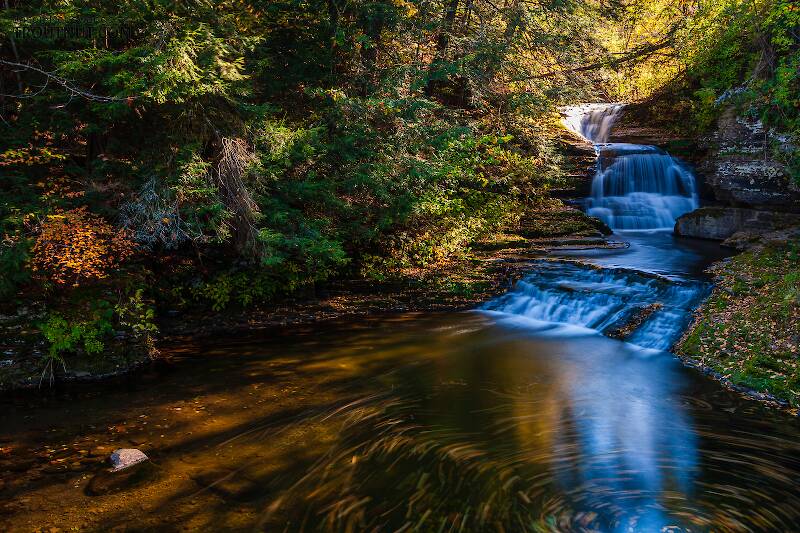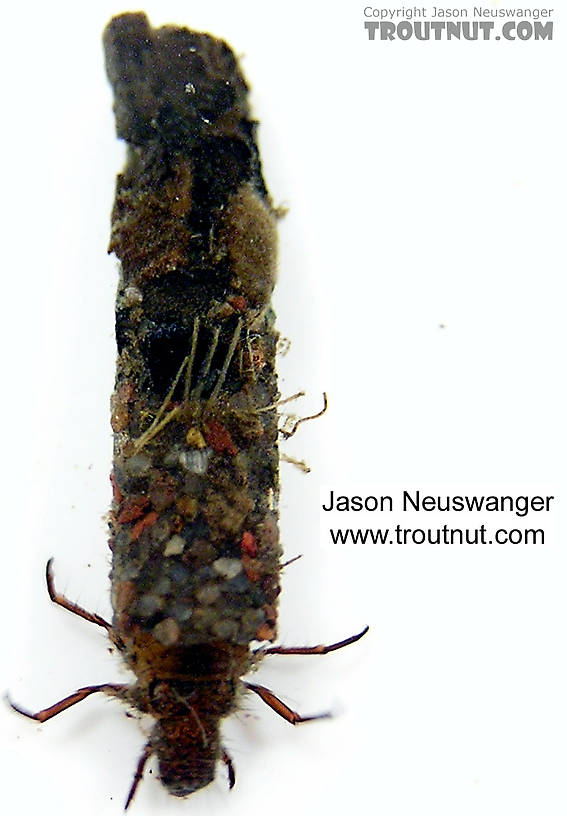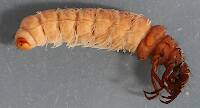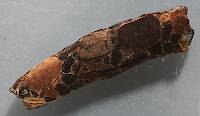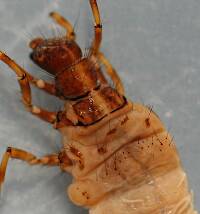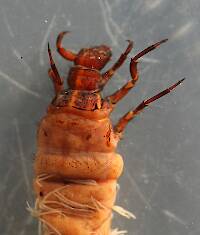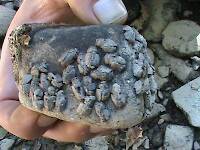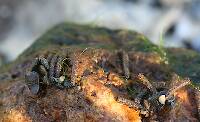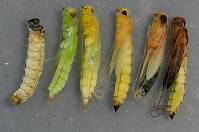
Hex Mayflies
Hexagenia limbata
The famous nocturnal Hex hatch of the Midwest (and a few other lucky locations) stirs to the surface mythically large brown trout that only touch streamers for the rest of the year.
Featured on the forum

Troutnut is a project started in 2003 by salmonid ecologist Jason "Troutnut" Neuswanger to help anglers and
fly tyers unabashedly embrace the entomological side of the sport. Learn more about Troutnut or
support the project for an enhanced experience here.
Martinlf on Apr 22, 2007April 22nd, 2007, 3:09 am EDT
OK, you caddis experts, time for a lesson. For me, that is. I visited a PA spring creek this weekend hoping to catch the Grannom hatch. When I arrived I found the bottom covered in cased larva. These cases were generally roundish, but very irregular looking; at first glance one might think they were very erroded branch sections hollowed out by the bug if he did not know different. They were just over an inch in length, and the critters inside looked like the one in Jason's photo, some more creamish, some more dirty white tending toward grey. The cases had long flat chunks of wood embedded in them lengthwise, in no particular order, creating a shaggy appearance. Now, I am guessing they were Grannoms, but previously I had thought of Grannoms as having square cases made of small twigs, arranged very neatly, not lengthwise, but side-wise, building a stacked wall to the case with definite visible lines. This kind of case is smaller at the tail and larger at the head. These cases, which I have observed in many streams, are typically dark, where the ones described above are light. The dark cases are smaller, too. I did find one of these small dark cases eventually, tightly sealed, and when I tried to open it, it definitely popped. The bug inside appeared to be a pupa, long dark legs and some dark squished body was all I could make out. When I have opened these in the past I found a blue-green larva. This is what I've always thought of as Grannoms around here. Are these two different species of Grannoms? There were a few adult Grannoms flitting about, dark bodies, grey wings, about a size 14. Does anyone want to hazard a guess about these two cased larva based on my descriptions? (Now I really know why they say a picture is worth a thousand words--unfortunately I don't carry a camera.) Also, if the bigger creamish bugs are in larva stage, massing on rocks, are they close to turning into pupa and hatching? Hmmm. How close I wonder.
"He spread them a yard and a half. 'And every one that got away is this big.'"
--Fred Chappell
--Fred Chappell
Troutnut on Apr 22, 2007April 22nd, 2007, 3:21 am EDT
The big ones sound like something from Limnephilidae, although I can't give any more detail. Maybe if Gonzo knows which stream you're talking about he can provide a more insightful guess.
Jason Neuswanger, Ph.D.
Troutnut and salmonid ecologist
Troutnut and salmonid ecologist
Martinlf on Apr 22, 2007April 22nd, 2007, 9:50 am EDT
Thanks for the suggestions; I'll go to my caddis books now to follow up and see if more progress can be made. It sounds like you guys may be suggesting that the bigger caddis may not be Grannoms, right? Do Grannoms always have the square cases? David, the bugs I found were on the rocks, but their cases were definitely made of wood, unlike the ones in Jason's 3 photos of pebble cased larva directly linked in at the top of this thread. Are these photos of Brachycentridae, or a general caddis photo? I was thinking if they are Brachycentridae, perhaps they also make wood cases. I did find an intact empty case for the larger bug and brought it back. Maybe I can get it to Gonzo for his analysis; I'm sure he knows the stream. I'm also wondering when these guys hatch and what the adults may look like; we're in for some good fishing (I hope) when it happens. Some of the books on PA streams may also give details about caddis hatches that are useful. Darn caddis, so much more confusing than mayflies.
"He spread them a yard and a half. 'And every one that got away is this big.'"
--Fred Chappell
--Fred Chappell
Quillgordon on Apr 22, 2007April 22nd, 2007, 10:41 am EDT
Perhaps it could be :
L. Platycentropus (chocolate and cream sedge)
@ 'strawman nymph'....... larva immitation
L. Hydatophylax ( giant cream pattern-wing sedge)
L. Pycnopsyche ( great brown autumn sedge)
* All common to N.E. PA.
** reference...... 'Caddisflies', G. LaFontaine
That's why we like them!
L. Platycentropus (chocolate and cream sedge)
@ 'strawman nymph'....... larva immitation
L. Hydatophylax ( giant cream pattern-wing sedge)
L. Pycnopsyche ( great brown autumn sedge)
* All common to N.E. PA.
** reference...... 'Caddisflies', G. LaFontaine
Darn caddis, so much more confusing than mayflies.
That's why we like them!
Flyfishing is a state of mind! .............. Q.g.
C/R........barbless
C/R........barbless
Troutnut on Apr 22, 2007April 22nd, 2007, 6:10 pm EDT
Louis, check out the case of the pupa I posted today. I'm assuming it's Brachycentrus until somebody corrects me.
Jason Neuswanger, Ph.D.
Troutnut and salmonid ecologist
Troutnut and salmonid ecologist
Taxon on Apr 22, 2007April 22nd, 2007, 8:51 pm EDT
RleeP on Apr 23, 2007April 23rd, 2007, 12:00 am EDT
From my handshake knowledge of most of this entomological stuff, the bigger ones certainly sound like Limnephilus to me. Especially at an inch or more in length. When I was a kid, we always called these things "stick caddis". In the small Crawford and Warren County (PA) streams where I cut my trout fishing teeth, they were thick everywhere the current slacked off in the margins of the stream.
On edit:
Louis writes:
"Also, if the bigger creamish bugs are in larva stage, massing on rocks, are they close to turning into pupa and hatching? Hmmm. How close I wonder."
Our stick caddis in the upper Allegheny drainage pupated in late August and were a big bug, a healthy #10-12..
On edit:
Louis writes:
"Also, if the bigger creamish bugs are in larva stage, massing on rocks, are they close to turning into pupa and hatching? Hmmm. How close I wonder."
Our stick caddis in the upper Allegheny drainage pupated in late August and were a big bug, a healthy #10-12..
Martinlf on Apr 23, 2007April 23rd, 2007, 1:22 am EDT
David, the case looks almost completely,if not entirely, made of sticks. Roger, it looks more like the first one you posted up, with a few of the long twigs removed, exposing an underlying cylinder made of smaller twigs and pieces of wood. The empty case I have may have been damaged when a trout removed the larva?? I didn't keep one of the live bugs--may do so next time I get up to the stream, perhaps tomorrow, if I'm lucky. I haven't seen the case Jason posted yet, but will look for it.
Found it. Neat photos. Jason, perhaps you should rename this thread,
"Not Grannoms, Probably Limnephilidae"
Found it. Neat photos. Jason, perhaps you should rename this thread,
"Not Grannoms, Probably Limnephilidae"
"He spread them a yard and a half. 'And every one that got away is this big.'"
--Fred Chappell
--Fred Chappell
GONZO on Apr 23, 2007April 23rd, 2007, 11:04 am EDT
Louis,
I'll have to wait to see the large case you describe, but Pycnopsyche and Hydatophylax (both Limnephilidae) are good possibilities.
Pycnopsyche, the Great Brown Autumn Sedge or Giant Red Sedge, typically attaches a few larger twigs lengthwise to it's rather cylindrical case. Hydatophylax argus, the Giant Cream Pattern-Wing Sedge, usually has rough chunks or strips of wood in a crude linear arrangement. H. argus emerges earlier, usually starting in very late May or early June in PA. If it's Pycnopsyche, they seal their cases and enter diapause for the summer and emerge in the fall. Both are found in parts of Fishing Creek.
Trout eat these big larvae case and all.
PS--I doubt that the larva in the photographs above is a grannom larva.
I'll have to wait to see the large case you describe, but Pycnopsyche and Hydatophylax (both Limnephilidae) are good possibilities.
Pycnopsyche, the Great Brown Autumn Sedge or Giant Red Sedge, typically attaches a few larger twigs lengthwise to it's rather cylindrical case. Hydatophylax argus, the Giant Cream Pattern-Wing Sedge, usually has rough chunks or strips of wood in a crude linear arrangement. H. argus emerges earlier, usually starting in very late May or early June in PA. If it's Pycnopsyche, they seal their cases and enter diapause for the summer and emerge in the fall. Both are found in parts of Fishing Creek.
The empty case I have may have been damaged when a trout removed the larva??
Trout eat these big larvae case and all.
PS--I doubt that the larva in the photographs above is a grannom larva.
Jlively on May 9, 2007May 9th, 2007, 10:33 am EDT
My local trout stream (freestone stream in southern NYS) is absolutely filthy with "stick caddis". They are everywhere you look, lined up in little rows facing up current. They make their cases out of little sticks, glued in parallel but with the ends not aligned. If you dissect one out of the case carefully you find it has a white to ginger colored body and black head. The cases are about 1" long.
I once tied up some imitations of the cases using wooden matches, but never got around to fishing them. (It would be easier to just take some cases, dry them off, and glue to a hook, come to think of it.)
This stream has many types of caddis so I never know exactly what's hatching, I just trying to generally match size and color, and if it doesn't work, I keep changing flies. I have used a large (size 10) LaFontaine sparkle pupae in white to some effect, however. I tied these to represent the caddis outside its case.
I once tied up some imitations of the cases using wooden matches, but never got around to fishing them. (It would be easier to just take some cases, dry them off, and glue to a hook, come to think of it.)
This stream has many types of caddis so I never know exactly what's hatching, I just trying to generally match size and color, and if it doesn't work, I keep changing flies. I have used a large (size 10) LaFontaine sparkle pupae in white to some effect, however. I tied these to represent the caddis outside its case.
Creno on Dec 22, 2007December 22nd, 2007, 10:50 am EST
This is a limnephilid - I suspect Onocosmoecus unicolor. But I cannot see the gill filaments well enough. If they are single filaments then this is not O.unicolor. O.unicolor should have about 4 filaments in each anterior gill clusters.
The character other than shape/size/color that leads me to Onocosmoecus is the change of case material from vegetation to mineral. This is rare in the typical limnephilid but also occurs in Hesperophylax. Hesperophylax has an even greater gill filament count with most anterior gills having 6 or more filaments.
The character other than shape/size/color that leads me to Onocosmoecus is the change of case material from vegetation to mineral. This is rare in the typical limnephilid but also occurs in Hesperophylax. Hesperophylax has an even greater gill filament count with most anterior gills having 6 or more filaments.
GONZO on May 22, 2008May 22nd, 2008, 10:57 am EDT
I'm just calling attention to this specimen again in the hope that Jason will move it--if not to Onocosmoecus, then at least to Limnephilidae. :)
Quick Reply
Related Discussions
Topic
Replies
Last Reply
2
Feb 15, 2013
by Troutnut
by Troutnut
0
Mar 23, 2010
by Troutboomer
by Troutboomer

